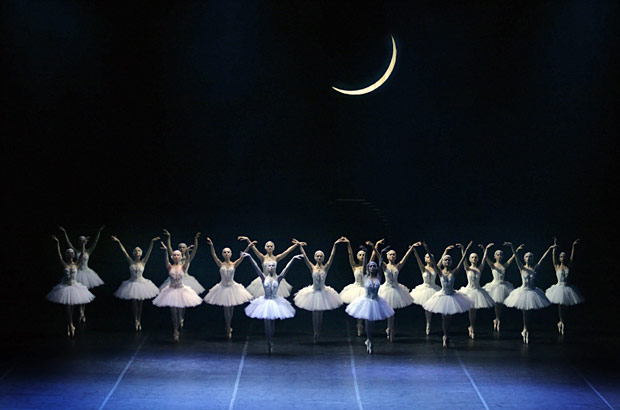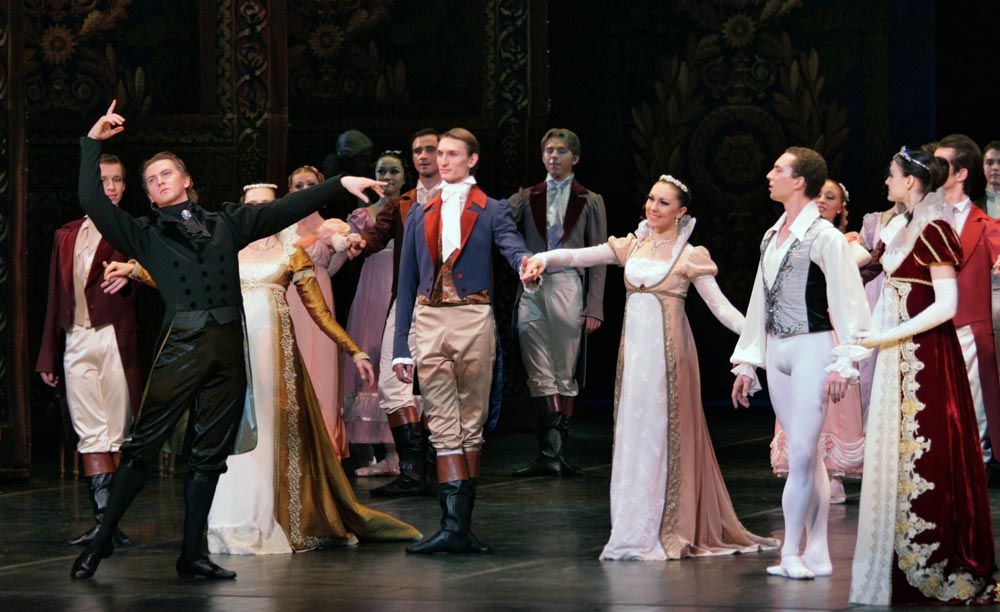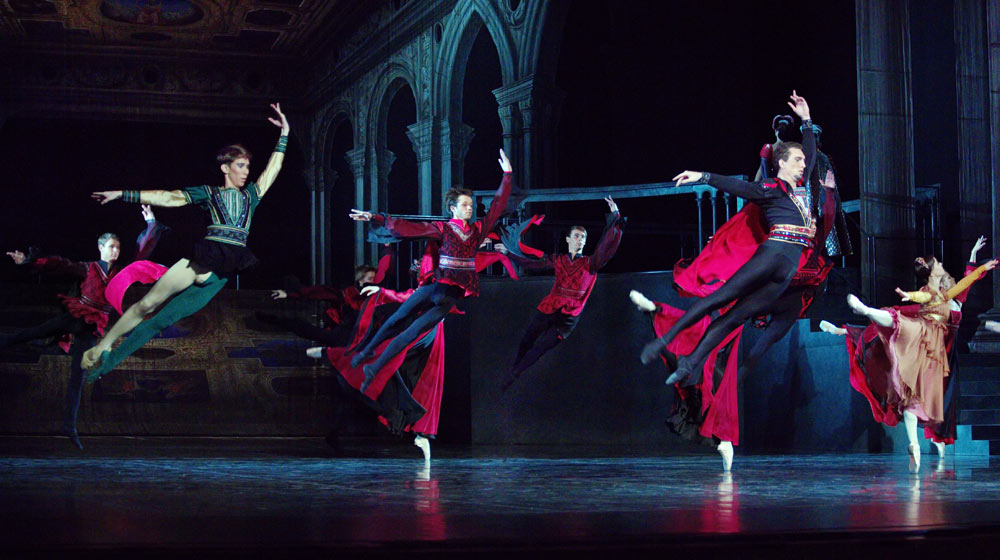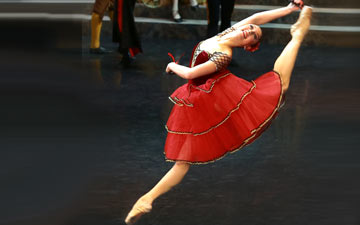
© Marina Panova. (Click image for larger version)
Russian State Ballet of Astrakhan
Swan Lake, Romeo and Juliet
Guildford, Yvonne Arnaud Theatre
27, 29 November 2013
amande-concerts.co.uk
www.dorkinghalls.co.uk
As its whistle-stop tour drew to its final week, the Russian State Ballet settled down for three consecutive days at Guildford’s Yvonne Arnaud Theatre. Here it offered one performance each of Swan Lake, The Nutcracker and Romeo and Juliet, on yet another small, intimate stage – always a challenge to Russians who are used to grand gestures and steps.
All three evenings saw sell-out performances. In the opening programme, Swan Lake, the audience enjoyed a truncated version created by artistic director, Konstantin Uralsky. In two acts – or ‘Pictures’ as they are called in the programme – and lasting just over two hours, he retells the classic story in a slightly different adaptation.
His Siegfried is a dreamer, a poetical figure who moons around the stage in his own world, acknowledging others when necessary but retreating into himself immediately afterwards. He is also a ‘mummy’s boy’, subservient to the Queen but also puppy-like in his devotion to her. While watching the guests and prospective brides at the ball, he holds her hand throughout. The reason for his lack of regal identity is the fact that Baron von Rothbart, a friend of the family, is also his tutor and thus controls him in his life and in his thoughts, obviously with a plan to govern the land also. The Baron has, as luck would have it, his own private theatre on the lake where he keeps a flock of dancing swan maidens. And when he decides the time is right, he takes the young innocent prince to see them, little thinking that the wimpish lad would have the gumption to fall in love with their leader, Odette. On first seeing her, Siegfried is struk and he becomes spellbound with her beauty. Swearing allegiance to her, he plans to present her at the ball as his fiancée. The story then proceeds as in the original version, though Uralsky uses another ballerina for the Black Swan, Odile, and at the finale, the two lovers perish in the rising waters of the lake.

© Marina Panova. (Click image for larger version)
It is an attractive production, even with only half the sets able to fit on the small stage. In Picture 1, the backdrop is a Gobelin tapestry showing the lake and the island. Here the birthday well-wishers perform two gentle and pleasing dances, with the girls in pretty peach and pink Empire line dresses, with hair in ringlets, while the boys wear tail coats –all very ‘War and Peace’-ish. The Prince stands out in his stark white tights and waistcoat. The Baron, of course, is in black with tall leather boots, while the Queen brightens the stage in her ruby red ‘Snow White’ velvet dress. There is a pretty Pas de Quatre by entertainers from the Baron’s theatre. Here, Karina Mannapova and Bulat Gareev, dressed like Dresden shepherdess figurines in pale lilac and green, were delicate and spirited, and their partners (Artur Almukhametov and Yuka Isiguro) showed off their style, with all four presenting themselves well in the final coda.
There is no Jester, but Benno the Prince’s friend is given the role’s music and does many of the ‘tricks’. Igor Likhanov showed off style and ability but played to the Guildford audience more than to the Prince’s court, thus making sure of applause. The swan maidens – 18 of them – dressed in lovely feather-light tutus, were uniform in their dancing, offering good straight lines and unified actions, and the three big swans, hampered a bit by lack of space, were strong yet refined. As always, the four little swans received the most applause. They were precise and sharp and, despite an elderly man in the centre of the middle stalls having to leave loudly for a bathroom visit just as they started, they all concentrated well. Slim, tall, long-limbed Natalia Korobeinikova danced Odette. She showed good balance and poses, and nice quivering arms, but her dancing did not always flow easily and she offered little characterization, especially in the final scene when she should have been evidencing pathos. There was sadly little connection, and certainly no eye contact, with her Prince, Danil Sokolov, who has an impressive jump – when space allowed – but he too was occasionally unsteady in his turns. (With 37 performances in six weeks –who in the company wouldn’t be a bit tired?)
The national costumes in Picture 2 were stunning – bright reds, blues, grey and black, lemon – and the character dancing was feisty and fun. It’s a fancy dress party and the Baron turns up as a knight in armour with his protégée, Odile. It’s obvious that the prince needs glasses, as this ballerina was completely different in shape and size to Odette. However, he decides that she is his true love. Though smiling broadly with anticipation, Aigul Ishbulatova, appeared ill at ease when dancing, and her first solo was somewhat uneven. Later, her fouettes –all singles – lost power, but she did offer some moments of pleasing movement, and though not seductive, was pretty to look at. The success of the production’s dancing however, goes to Alexander Zverev as Baron von Rothbart who was powerful, played his character convincingly and has a nice fluid style with good taut technique.

© Marina Panova. (Click image for larger version)
The second show – The Nutcracker – was reviewed in Dorking last week. So to the third – Romeo and Juliet, a lively production in which each member of the company got the chance to show real characterization and enjoyment. Uralsky’s production tells Shakespeare’s play in shortened form, yet it works well, and includes all necessary moments. Prokofiev’s wonderful score has been cut – and not always successfully to a trained ear – to make the scenes shorter. But one has to take into account the audience that this tour is aimed at: people of all ages, many new to ballet, who hopefully will now develop a desire to see more. The orchestra, under Sergei Grinev, played well though, crushed into the small pit, the sound was occasionally muffled.
In this ballet, Uralsky gives roles to all of his principals, enabling each to show off different styles and acting ability. Danil Sokolov as Romeo, finally discarded the lethargy and imprecision seen in his Siegfried and as consort to the Sugar Plum Fairy, and, though Romeo is still a dreamer, he acted with more passion and understanding, and his technique was more assured. He presented a light fluid style to his solos and always looked elegant. His Juliet was Maria Stec, who had been off sick at earlier productions, so this was my first sighting of her. She is a beautiful dancer, sensitive and delicate with wonderfully eloquent arms and fleeting backwards bourrees. And she is a good actress too, showing with genuine feeling, the development from childish play to first love, and later evidencing courage and determination when contemplating the effects of the sleep potion.
Being tall, Alexander Zverev, (Baron von Rothbart in Swan Lake), made a physically larger Mercutio than is usually depicted. But he managed all the tricky turns and footwork well, and brought a true sense of fun to the character. Benvolio, Romeo’s other friend, is given more opportunity to dance, and Artur Almukhametov showed off a youthful and polished style. Principal Natalia Korobeinikova – the White Swan two nights before – danced Juliet’s Nurse and looked as though she was enjoying herself. Her character here is a young peasant girl who likes to try on Juliet’s clothes – first her ball gown, then a dress for her trip to the market. Comically she tries to add the airs and graces of aristocracy but fails, grimacing and stumbling as she goes, and Korobeinikova played her well to a chuckling audience..

© Marina Panova. (Click image for larger version)
I was impressed with Rudolf Dudoladov as Tybalt, who made a strong presence on stage with powerful jumps and vigorous thrustings in the sword fights. Also impressive, in a diametrically opposite way, was Maksim Melnikov as Friar Lawrence. His character here has more dancing and acting to do, and he performed well showing good lines and control in his interpretation of the understanding and peace-loving spiritual mentor.
The market scenes were lively and the sword fights well staged so that the drama kept flowing. Uralsky introduces white-clad angel-like apparitions, seen briefly through the scrim in the prologue as the main characters slowly mingle. And they are present too in the bedroom during the pas de deux, and in the crypt when the lovers die. There is also a long swathe of white silk that appears throughout the ballet – as a cloak for Romeo, a bed sheet for the couple, and a cover for their two bodies on their tomb. Uralsky includes the figure of Queen Mab, fairy of dreams, (normally left out of productions), who appears to Mercutio in times of decision and at his death. There is also the, new to me, medieval tradition, first seen at the ball, of a young girl giving her detachable sleeve to a prospective young man, and it is one of Juliet’s sleeves that the nurse gives to Romeo in the market place, rather than a letter.
All three productions were well received by their audiences who enjoyed the dancing, music and colourful costumes of these three popular Russian classical ballets. The Russian State Ballet returns to its southern home city of Astrakhan on the Volga River and the Caspian Sea, pleased with the reception it received on its first tour here, and with anticipation of returning to the UK in the near future.
















You must be logged in to post a comment.